Learning Across the Early Childhood Curriculum
VerifiedAdded on 2023/04/11
|9
|1951
|293
AI Summary
This article discusses the importance of play in early childhood learning and the design of learning sectors. It also explores mathematical tasks, writing competences, and other subjects like sports, social studies, and melody and animatronics.
Contribute Materials
Your contribution can guide someone’s learning journey. Share your
documents today.
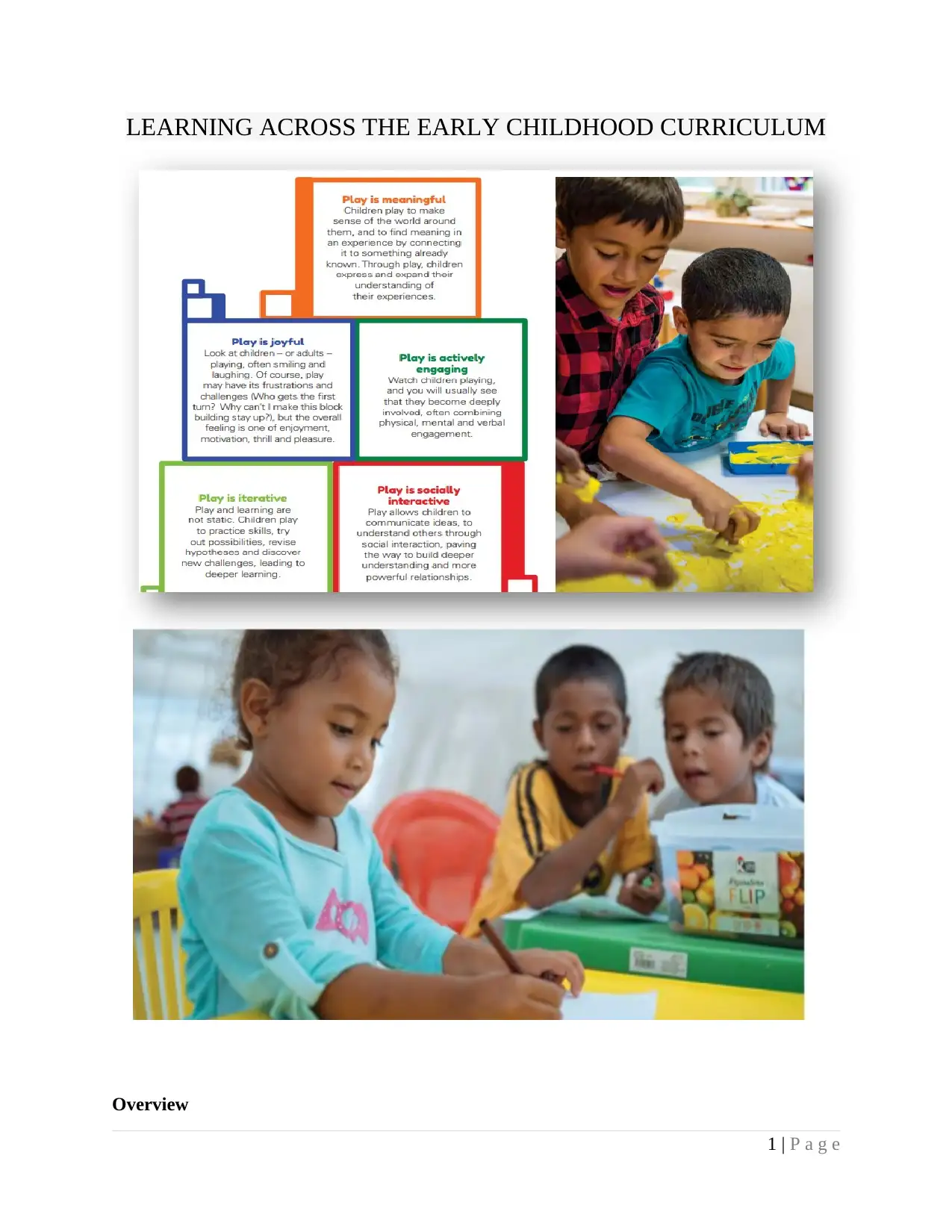
LEARNING ACROSS THE EARLY CHILDHOOD CURRICULUM
Overview
1 | P a g e
Overview
1 | P a g e
Secure Best Marks with AI Grader
Need help grading? Try our AI Grader for instant feedback on your assignments.
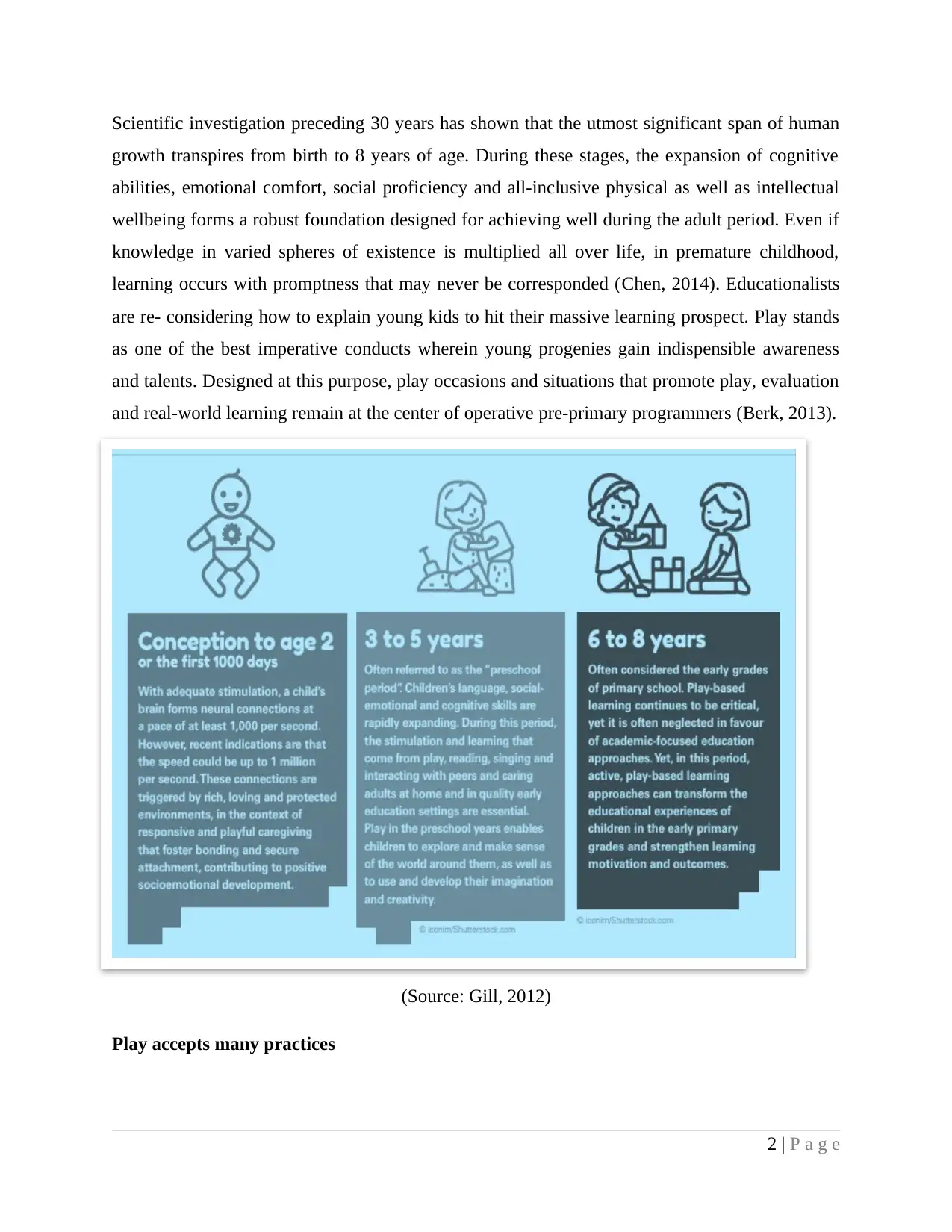
Scientific investigation preceding 30 years has shown that the utmost significant span of human
growth transpires from birth to 8 years of age. During these stages, the expansion of cognitive
abilities, emotional comfort, social proficiency and all-inclusive physical as well as intellectual
wellbeing forms a robust foundation designed for achieving well during the adult period. Even if
knowledge in varied spheres of existence is multiplied all over life, in premature childhood,
learning occurs with promptness that may never be corresponded (Chen, 2014). Educationalists
are re- considering how to explain young kids to hit their massive learning prospect. Play stands
as one of the best imperative conducts wherein young progenies gain indispensible awareness
and talents. Designed at this purpose, play occasions and situations that promote play, evaluation
and real-world learning remain at the center of operative pre-primary programmers (Berk, 2013).
(Source: Gill, 2012)
Play accepts many practices
2 | P a g e
growth transpires from birth to 8 years of age. During these stages, the expansion of cognitive
abilities, emotional comfort, social proficiency and all-inclusive physical as well as intellectual
wellbeing forms a robust foundation designed for achieving well during the adult period. Even if
knowledge in varied spheres of existence is multiplied all over life, in premature childhood,
learning occurs with promptness that may never be corresponded (Chen, 2014). Educationalists
are re- considering how to explain young kids to hit their massive learning prospect. Play stands
as one of the best imperative conducts wherein young progenies gain indispensible awareness
and talents. Designed at this purpose, play occasions and situations that promote play, evaluation
and real-world learning remain at the center of operative pre-primary programmers (Berk, 2013).
(Source: Gill, 2012)
Play accepts many practices
2 | P a g e
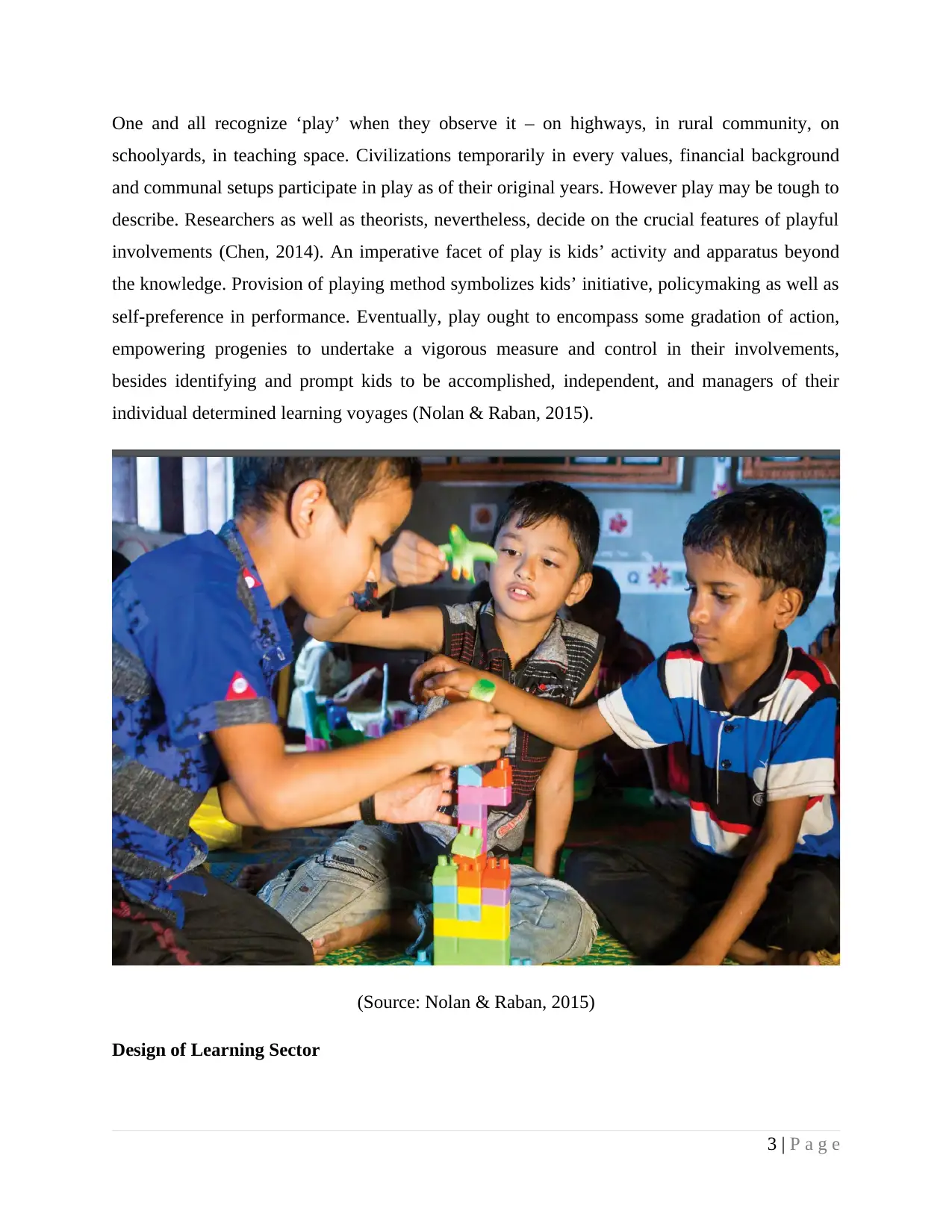
One and all recognize ‘play’ when they observe it – on highways, in rural community, on
schoolyards, in teaching space. Civilizations temporarily in every values, financial background
and communal setups participate in play as of their original years. However play may be tough to
describe. Researchers as well as theorists, nevertheless, decide on the crucial features of playful
involvements (Chen, 2014). An imperative facet of play is kids’ activity and apparatus beyond
the knowledge. Provision of playing method symbolizes kids’ initiative, policymaking as well as
self-preference in performance. Eventually, play ought to encompass some gradation of action,
empowering progenies to undertake a vigorous measure and control in their involvements,
besides identifying and prompt kids to be accomplished, independent, and managers of their
individual determined learning voyages (Nolan & Raban, 2015).
(Source: Nolan & Raban, 2015)
Design of Learning Sector
3 | P a g e
schoolyards, in teaching space. Civilizations temporarily in every values, financial background
and communal setups participate in play as of their original years. However play may be tough to
describe. Researchers as well as theorists, nevertheless, decide on the crucial features of playful
involvements (Chen, 2014). An imperative facet of play is kids’ activity and apparatus beyond
the knowledge. Provision of playing method symbolizes kids’ initiative, policymaking as well as
self-preference in performance. Eventually, play ought to encompass some gradation of action,
empowering progenies to undertake a vigorous measure and control in their involvements,
besides identifying and prompt kids to be accomplished, independent, and managers of their
individual determined learning voyages (Nolan & Raban, 2015).
(Source: Nolan & Raban, 2015)
Design of Learning Sector
3 | P a g e
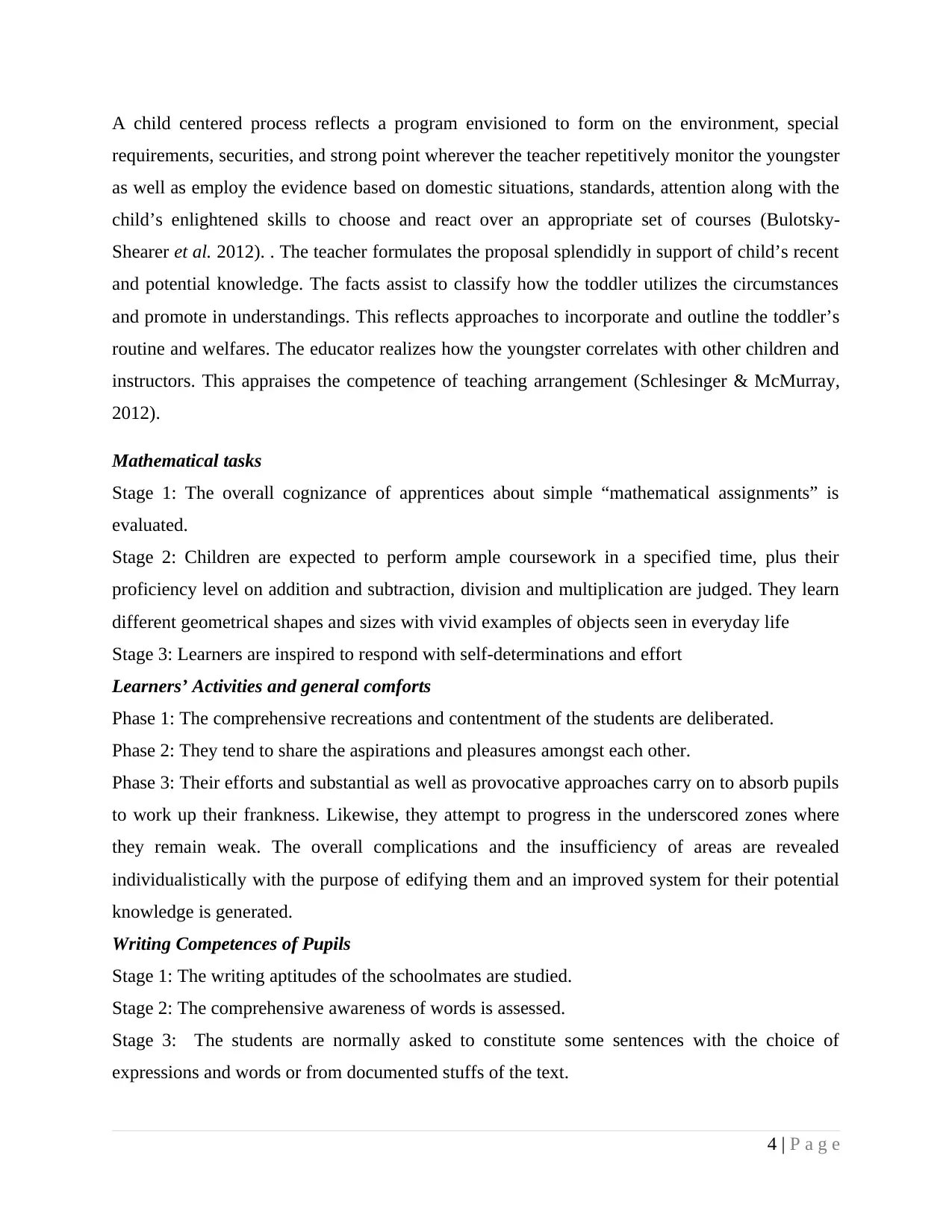
A child centered process reflects a program envisioned to form on the environment, special
requirements, securities, and strong point wherever the teacher repetitively monitor the youngster
as well as employ the evidence based on domestic situations, standards, attention along with the
child’s enlightened skills to choose and react over an appropriate set of courses (Bulotsky-
Shearer et al. 2012). . The teacher formulates the proposal splendidly in support of child’s recent
and potential knowledge. The facts assist to classify how the toddler utilizes the circumstances
and promote in understandings. This reflects approaches to incorporate and outline the toddler’s
routine and welfares. The educator realizes how the youngster correlates with other children and
instructors. This appraises the competence of teaching arrangement (Schlesinger & McMurray,
2012).
Mathematical tasks
Stage 1: The overall cognizance of apprentices about simple “mathematical assignments” is
evaluated.
Stage 2: Children are expected to perform ample coursework in a specified time, plus their
proficiency level on addition and subtraction, division and multiplication are judged. They learn
different geometrical shapes and sizes with vivid examples of objects seen in everyday life
Stage 3: Learners are inspired to respond with self-determinations and effort
Learners’ Activities and general comforts
Phase 1: The comprehensive recreations and contentment of the students are deliberated.
Phase 2: They tend to share the aspirations and pleasures amongst each other.
Phase 3: Their efforts and substantial as well as provocative approaches carry on to absorb pupils
to work up their frankness. Likewise, they attempt to progress in the underscored zones where
they remain weak. The overall complications and the insufficiency of areas are revealed
individualistically with the purpose of edifying them and an improved system for their potential
knowledge is generated.
Writing Competences of Pupils
Stage 1: The writing aptitudes of the schoolmates are studied.
Stage 2: The comprehensive awareness of words is assessed.
Stage 3: The students are normally asked to constitute some sentences with the choice of
expressions and words or from documented stuffs of the text.
4 | P a g e
requirements, securities, and strong point wherever the teacher repetitively monitor the youngster
as well as employ the evidence based on domestic situations, standards, attention along with the
child’s enlightened skills to choose and react over an appropriate set of courses (Bulotsky-
Shearer et al. 2012). . The teacher formulates the proposal splendidly in support of child’s recent
and potential knowledge. The facts assist to classify how the toddler utilizes the circumstances
and promote in understandings. This reflects approaches to incorporate and outline the toddler’s
routine and welfares. The educator realizes how the youngster correlates with other children and
instructors. This appraises the competence of teaching arrangement (Schlesinger & McMurray,
2012).
Mathematical tasks
Stage 1: The overall cognizance of apprentices about simple “mathematical assignments” is
evaluated.
Stage 2: Children are expected to perform ample coursework in a specified time, plus their
proficiency level on addition and subtraction, division and multiplication are judged. They learn
different geometrical shapes and sizes with vivid examples of objects seen in everyday life
Stage 3: Learners are inspired to respond with self-determinations and effort
Learners’ Activities and general comforts
Phase 1: The comprehensive recreations and contentment of the students are deliberated.
Phase 2: They tend to share the aspirations and pleasures amongst each other.
Phase 3: Their efforts and substantial as well as provocative approaches carry on to absorb pupils
to work up their frankness. Likewise, they attempt to progress in the underscored zones where
they remain weak. The overall complications and the insufficiency of areas are revealed
individualistically with the purpose of edifying them and an improved system for their potential
knowledge is generated.
Writing Competences of Pupils
Stage 1: The writing aptitudes of the schoolmates are studied.
Stage 2: The comprehensive awareness of words is assessed.
Stage 3: The students are normally asked to constitute some sentences with the choice of
expressions and words or from documented stuffs of the text.
4 | P a g e
Secure Best Marks with AI Grader
Need help grading? Try our AI Grader for instant feedback on your assignments.
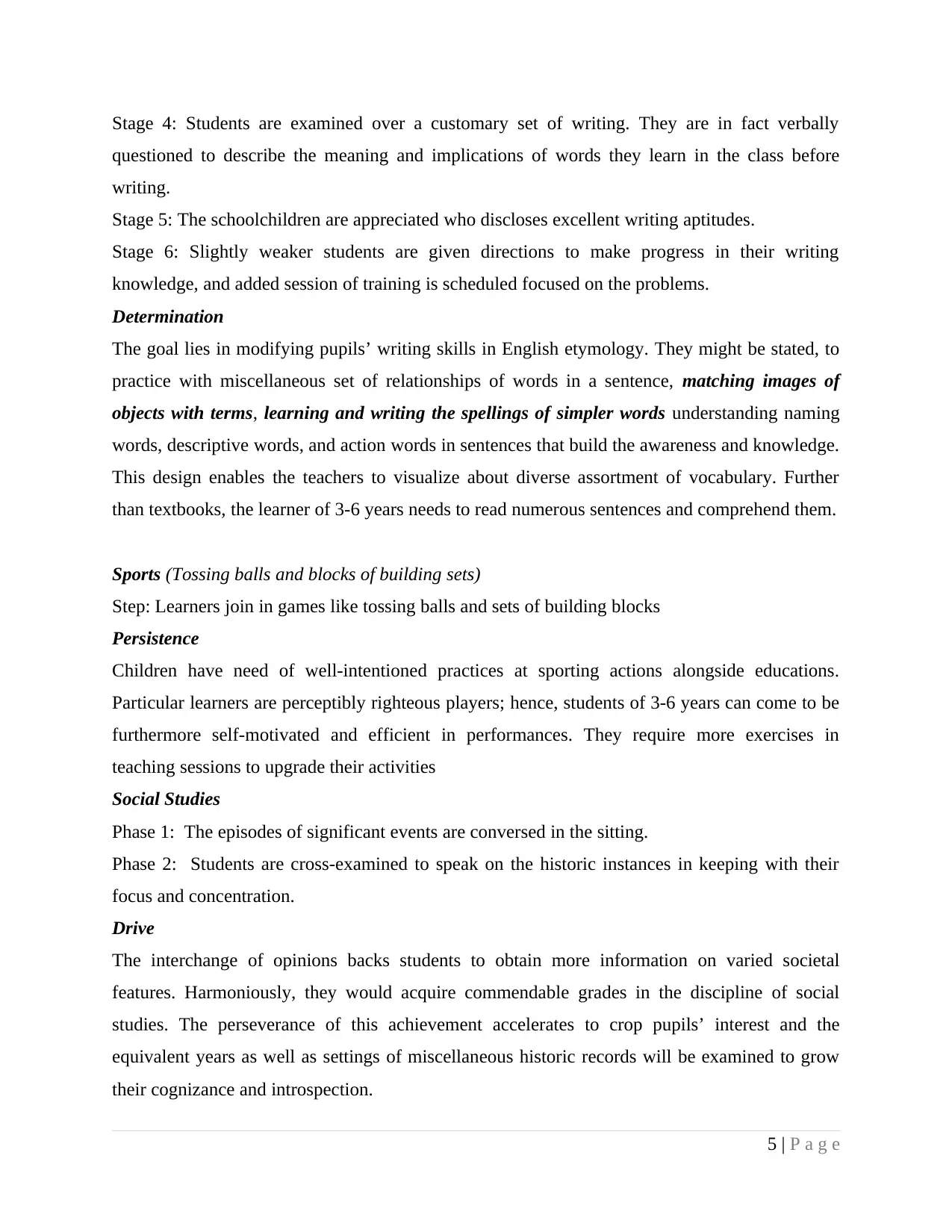
Stage 4: Students are examined over a customary set of writing. They are in fact verbally
questioned to describe the meaning and implications of words they learn in the class before
writing.
Stage 5: The schoolchildren are appreciated who discloses excellent writing aptitudes.
Stage 6: Slightly weaker students are given directions to make progress in their writing
knowledge, and added session of training is scheduled focused on the problems.
Determination
The goal lies in modifying pupils’ writing skills in English etymology. They might be stated, to
practice with miscellaneous set of relationships of words in a sentence, matching images of
objects with terms, learning and writing the spellings of simpler words understanding naming
words, descriptive words, and action words in sentences that build the awareness and knowledge.
This design enables the teachers to visualize about diverse assortment of vocabulary. Further
than textbooks, the learner of 3-6 years needs to read numerous sentences and comprehend them.
Sports (Tossing balls and blocks of building sets)
Step: Learners join in games like tossing balls and sets of building blocks
Persistence
Children have need of well-intentioned practices at sporting actions alongside educations.
Particular learners are perceptibly righteous players; hence, students of 3-6 years can come to be
furthermore self-motivated and efficient in performances. They require more exercises in
teaching sessions to upgrade their activities
Social Studies
Phase 1: The episodes of significant events are conversed in the sitting.
Phase 2: Students are cross-examined to speak on the historic instances in keeping with their
focus and concentration.
Drive
The interchange of opinions backs students to obtain more information on varied societal
features. Harmoniously, they would acquire commendable grades in the discipline of social
studies. The perseverance of this achievement accelerates to crop pupils’ interest and the
equivalent years as well as settings of miscellaneous historic records will be examined to grow
their cognizance and introspection.
5 | P a g e
questioned to describe the meaning and implications of words they learn in the class before
writing.
Stage 5: The schoolchildren are appreciated who discloses excellent writing aptitudes.
Stage 6: Slightly weaker students are given directions to make progress in their writing
knowledge, and added session of training is scheduled focused on the problems.
Determination
The goal lies in modifying pupils’ writing skills in English etymology. They might be stated, to
practice with miscellaneous set of relationships of words in a sentence, matching images of
objects with terms, learning and writing the spellings of simpler words understanding naming
words, descriptive words, and action words in sentences that build the awareness and knowledge.
This design enables the teachers to visualize about diverse assortment of vocabulary. Further
than textbooks, the learner of 3-6 years needs to read numerous sentences and comprehend them.
Sports (Tossing balls and blocks of building sets)
Step: Learners join in games like tossing balls and sets of building blocks
Persistence
Children have need of well-intentioned practices at sporting actions alongside educations.
Particular learners are perceptibly righteous players; hence, students of 3-6 years can come to be
furthermore self-motivated and efficient in performances. They require more exercises in
teaching sessions to upgrade their activities
Social Studies
Phase 1: The episodes of significant events are conversed in the sitting.
Phase 2: Students are cross-examined to speak on the historic instances in keeping with their
focus and concentration.
Drive
The interchange of opinions backs students to obtain more information on varied societal
features. Harmoniously, they would acquire commendable grades in the discipline of social
studies. The perseverance of this achievement accelerates to crop pupils’ interest and the
equivalent years as well as settings of miscellaneous historic records will be examined to grow
their cognizance and introspection.
5 | P a g e

Melody plus Animatronics
Step 1: Pupils will get involvement of diverse resources such as, kids’ moving picture, animation
software and computer graphics with musical devices, and equipment.
Step 2: As a final point, they may be appraised to cognize what they grasped
Resolution
The inventiveness of these events stands to produce artistic talents. Furthermore, learners would
address on explicit feature they mostly have a fondness. At this step, it is vivacious for students
to give a lift to the uniqueness of animatronics as it deals with life and the characters with
components that stand to interconnect with the onlookers competently. Congruently, from a
teaching perspective, the reproduction of cartoons generates the paramount working conducts to
subsidize an “impression of broadcasting media”.
Discussion of incorporating method and skills
The integrated technique in exchanging cultural systems with array of age groups inspires
learner’s assertion. The alignment to computerized tools besides devices, audio-visual
exhibitions created on digital systems etc. persisted to be promising outstanding conception of
the stuff while projecting educational expansions for beginners (Rachman, 2015).
“When youngsters specify to play, they do not consider that they might learn to some degree
from this action.” However their performance crafts dominant learning chances through all
extents of development. Evolution and knowledge are multifaceted and all-inclusive and so far
abilities through all developing areas can be reinvigorated over play, together with motor,
reasoning and social and expressive talents. Certainly, in lively participations, kids tap an
extensiveness of talents at any single time. Frequently this happens in the course of ‘corner play’
or Centre stage in the setting of primary education or pre-primary packages. Corner play, while
well scheduled, stimulates child improvement and learning proficiencies more meritoriously than
any additional pre-primary action (www.earlychildhoodaustralia.org.au, 2019). By selecting to
accomplish with the belongings they intend to establish, children really mature skills in whole
extents of expansion: intellectual, communal, responsive and physical. For instance, while kids
play, they may attempt innovative societal skills (e.g., sharing dolls, harmonizing how to pool
resources with requirements), as well as they habitually assume some thought-provoking
reasoning tasks (for instance, presuming out by what means to create a building with less
6 | P a g e
Step 1: Pupils will get involvement of diverse resources such as, kids’ moving picture, animation
software and computer graphics with musical devices, and equipment.
Step 2: As a final point, they may be appraised to cognize what they grasped
Resolution
The inventiveness of these events stands to produce artistic talents. Furthermore, learners would
address on explicit feature they mostly have a fondness. At this step, it is vivacious for students
to give a lift to the uniqueness of animatronics as it deals with life and the characters with
components that stand to interconnect with the onlookers competently. Congruently, from a
teaching perspective, the reproduction of cartoons generates the paramount working conducts to
subsidize an “impression of broadcasting media”.
Discussion of incorporating method and skills
The integrated technique in exchanging cultural systems with array of age groups inspires
learner’s assertion. The alignment to computerized tools besides devices, audio-visual
exhibitions created on digital systems etc. persisted to be promising outstanding conception of
the stuff while projecting educational expansions for beginners (Rachman, 2015).
“When youngsters specify to play, they do not consider that they might learn to some degree
from this action.” However their performance crafts dominant learning chances through all
extents of development. Evolution and knowledge are multifaceted and all-inclusive and so far
abilities through all developing areas can be reinvigorated over play, together with motor,
reasoning and social and expressive talents. Certainly, in lively participations, kids tap an
extensiveness of talents at any single time. Frequently this happens in the course of ‘corner play’
or Centre stage in the setting of primary education or pre-primary packages. Corner play, while
well scheduled, stimulates child improvement and learning proficiencies more meritoriously than
any additional pre-primary action (www.earlychildhoodaustralia.org.au, 2019). By selecting to
accomplish with the belongings they intend to establish, children really mature skills in whole
extents of expansion: intellectual, communal, responsive and physical. For instance, while kids
play, they may attempt innovative societal skills (e.g., sharing dolls, harmonizing how to pool
resources with requirements), as well as they habitually assume some thought-provoking
reasoning tasks (for instance, presuming out by what means to create a building with less
6 | P a g e
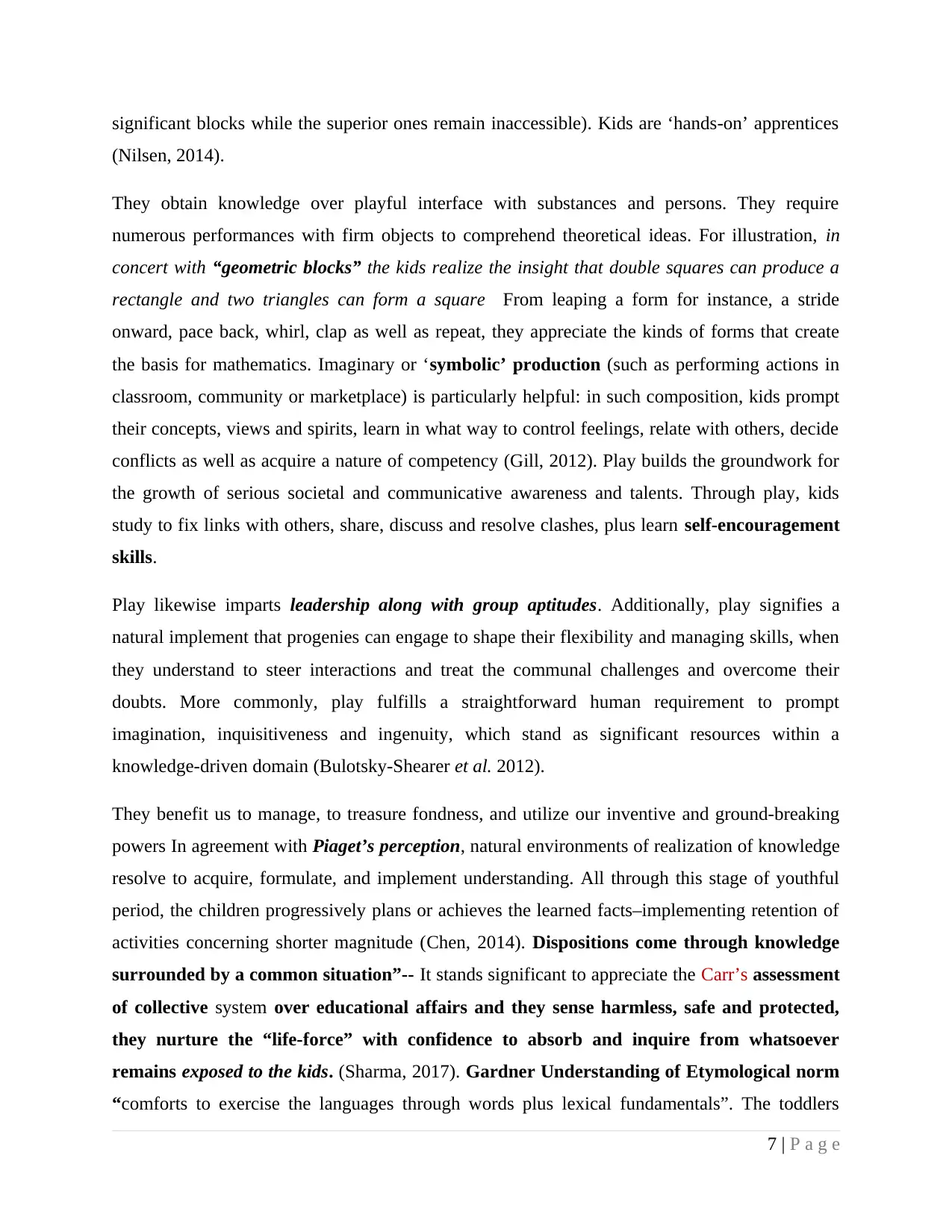
significant blocks while the superior ones remain inaccessible). Kids are ‘hands-on’ apprentices
(Nilsen, 2014).
They obtain knowledge over playful interface with substances and persons. They require
numerous performances with firm objects to comprehend theoretical ideas. For illustration, in
concert with “geometric blocks” the kids realize the insight that double squares can produce a
rectangle and two triangles can form a square From leaping a form for instance, a stride
onward, pace back, whirl, clap as well as repeat, they appreciate the kinds of forms that create
the basis for mathematics. Imaginary or ‘symbolic’ production (such as performing actions in
classroom, community or marketplace) is particularly helpful: in such composition, kids prompt
their concepts, views and spirits, learn in what way to control feelings, relate with others, decide
conflicts as well as acquire a nature of competency (Gill, 2012). Play builds the groundwork for
the growth of serious societal and communicative awareness and talents. Through play, kids
study to fix links with others, share, discuss and resolve clashes, plus learn self-encouragement
skills.
Play likewise imparts leadership along with group aptitudes. Additionally, play signifies a
natural implement that progenies can engage to shape their flexibility and managing skills, when
they understand to steer interactions and treat the communal challenges and overcome their
doubts. More commonly, play fulfills a straightforward human requirement to prompt
imagination, inquisitiveness and ingenuity, which stand as significant resources within a
knowledge-driven domain (Bulotsky-Shearer et al. 2012).
They benefit us to manage, to treasure fondness, and utilize our inventive and ground-breaking
powers In agreement with Piaget’s perception, natural environments of realization of knowledge
resolve to acquire, formulate, and implement understanding. All through this stage of youthful
period, the children progressively plans or achieves the learned facts–implementing retention of
activities concerning shorter magnitude (Chen, 2014). Dispositions come through knowledge
surrounded by a common situation”-- It stands significant to appreciate the Carr’s assessment
of collective system over educational affairs and they sense harmless, safe and protected,
they nurture the “life-force” with confidence to absorb and inquire from whatsoever
remains exposed to the kids. (Sharma, 2017). Gardner Understanding of Etymological norm
“comforts to exercise the languages through words plus lexical fundamentals”. The toddlers
7 | P a g e
(Nilsen, 2014).
They obtain knowledge over playful interface with substances and persons. They require
numerous performances with firm objects to comprehend theoretical ideas. For illustration, in
concert with “geometric blocks” the kids realize the insight that double squares can produce a
rectangle and two triangles can form a square From leaping a form for instance, a stride
onward, pace back, whirl, clap as well as repeat, they appreciate the kinds of forms that create
the basis for mathematics. Imaginary or ‘symbolic’ production (such as performing actions in
classroom, community or marketplace) is particularly helpful: in such composition, kids prompt
their concepts, views and spirits, learn in what way to control feelings, relate with others, decide
conflicts as well as acquire a nature of competency (Gill, 2012). Play builds the groundwork for
the growth of serious societal and communicative awareness and talents. Through play, kids
study to fix links with others, share, discuss and resolve clashes, plus learn self-encouragement
skills.
Play likewise imparts leadership along with group aptitudes. Additionally, play signifies a
natural implement that progenies can engage to shape their flexibility and managing skills, when
they understand to steer interactions and treat the communal challenges and overcome their
doubts. More commonly, play fulfills a straightforward human requirement to prompt
imagination, inquisitiveness and ingenuity, which stand as significant resources within a
knowledge-driven domain (Bulotsky-Shearer et al. 2012).
They benefit us to manage, to treasure fondness, and utilize our inventive and ground-breaking
powers In agreement with Piaget’s perception, natural environments of realization of knowledge
resolve to acquire, formulate, and implement understanding. All through this stage of youthful
period, the children progressively plans or achieves the learned facts–implementing retention of
activities concerning shorter magnitude (Chen, 2014). Dispositions come through knowledge
surrounded by a common situation”-- It stands significant to appreciate the Carr’s assessment
of collective system over educational affairs and they sense harmless, safe and protected,
they nurture the “life-force” with confidence to absorb and inquire from whatsoever
remains exposed to the kids. (Sharma, 2017). Gardner Understanding of Etymological norm
“comforts to exercise the languages through words plus lexical fundamentals”. The toddlers
7 | P a g e
Paraphrase This Document
Need a fresh take? Get an instant paraphrase of this document with our AI Paraphraser
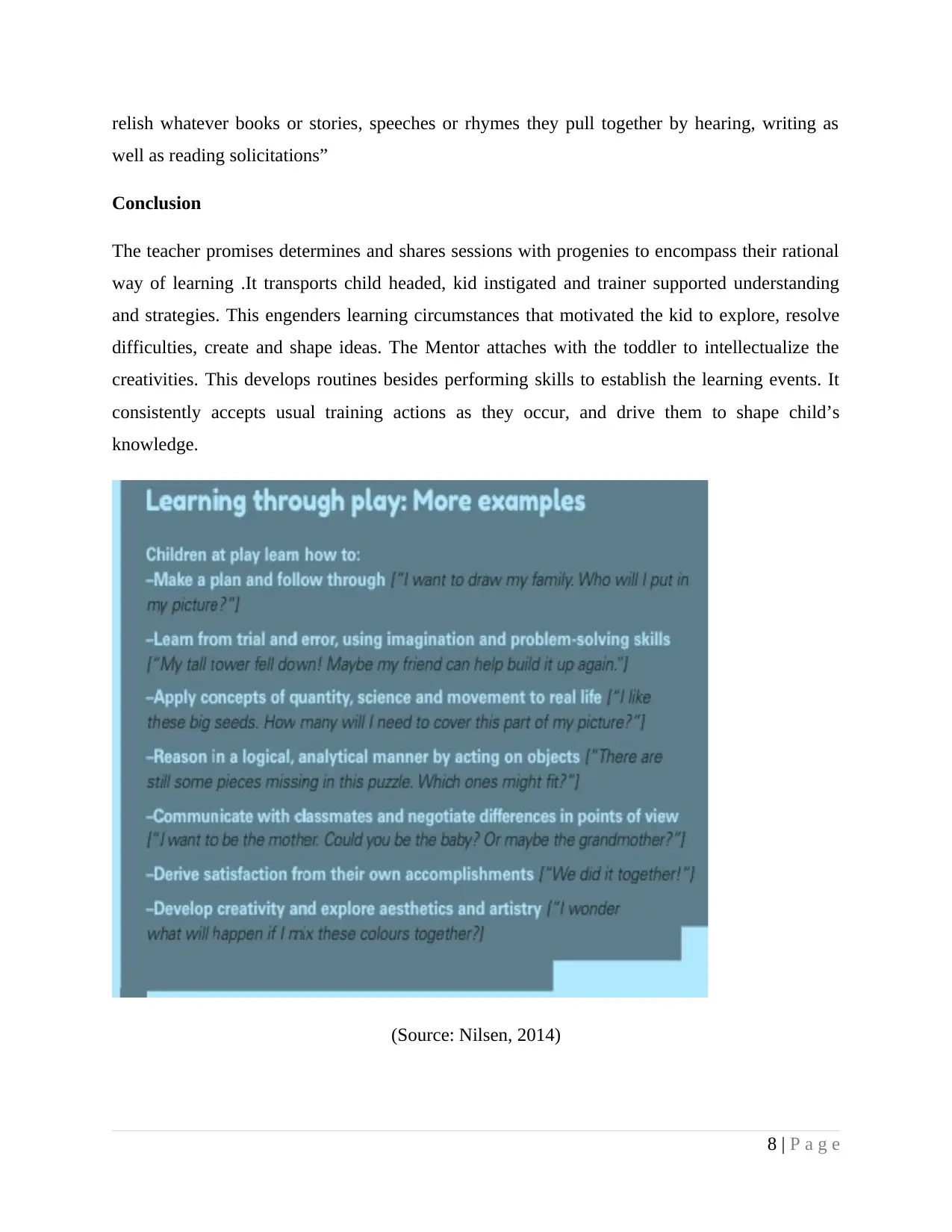
relish whatever books or stories, speeches or rhymes they pull together by hearing, writing as
well as reading solicitations”
Conclusion
The teacher promises determines and shares sessions with progenies to encompass their rational
way of learning .It transports child headed, kid instigated and trainer supported understanding
and strategies. This engenders learning circumstances that motivated the kid to explore, resolve
difficulties, create and shape ideas. The Mentor attaches with the toddler to intellectualize the
creativities. This develops routines besides performing skills to establish the learning events. It
consistently accepts usual training actions as they occur, and drive them to shape child’s
knowledge.
(Source: Nilsen, 2014)
8 | P a g e
well as reading solicitations”
Conclusion
The teacher promises determines and shares sessions with progenies to encompass their rational
way of learning .It transports child headed, kid instigated and trainer supported understanding
and strategies. This engenders learning circumstances that motivated the kid to explore, resolve
difficulties, create and shape ideas. The Mentor attaches with the toddler to intellectualize the
creativities. This develops routines besides performing skills to establish the learning events. It
consistently accepts usual training actions as they occur, and drive them to shape child’s
knowledge.
(Source: Nilsen, 2014)
8 | P a g e

References
Berk, L. (2013). Child development (9th ed.) (Chapter 6). USA: Pearson Education.
Bulotsky-Shearer, R., Dominguez, X., & Bell, E. (2012). Preschool classroom behavioral context
and school readiness outcomes for low-income children: A multilevel examination of
child- and classroom-level influences. Journal Of Educational Psychology, 104(2), 421-
438. http://dx.doi.org/10.1037/a0026301
Chen, F. (2014). Parents'perezhivaniesupports children's development of emotion regulation: a
holistic view. Early Child Development And Care, 185(6), 851-867. doi:
10.1080/03004430.2014.961445
Gill, N. (2012). Sharing responsibility — A holistic approach to addressing early childhood
caries. Indian Pediatrics, 49(9), 763-763. doi: 10.1007/s13312-012-0145-y
Nilsen, B. (2014). Week by week: Plans for documenting children’s development (7th ed.)
(Chapter 8). USA: Cengage.
Nolan, A., & Raban, B. (2015). Theories into practice: Understanding and rethinking our work
with young children (Chapter 2). Victoria, Australia: Teaching Solutions.
Rachman, S. (2015). The evolution of behaviour therapy and cognitive behaviour therapy.
Behaviour Research And Therapy, 64, pp 1-8.
http://dx.doi.org/10.1016/j.brat.2014.10.006
Schlesinger, M., & McMurray, B. (2012). The past, present, and future of computational models
of cognitive development. Cognitive Development, 27(4), 326-348. doi:
10.1016/j.cogdev.2012.07.002
Sharma, A. (2017). Child Development………A Holistic Approach. Samajbodh, 7(1), 133. doi:
10.5958/2321-5860.2017.00041.8
www.earlychildhoodaustralia.org.au (2019). Retrieved from
http://www.earlychildhoodaustralia.org.au/nqsplp/wp-
content/uploads/2012/05/EYLFPLP_E-Newsletter_No17.pdf
9 | P a g e
Berk, L. (2013). Child development (9th ed.) (Chapter 6). USA: Pearson Education.
Bulotsky-Shearer, R., Dominguez, X., & Bell, E. (2012). Preschool classroom behavioral context
and school readiness outcomes for low-income children: A multilevel examination of
child- and classroom-level influences. Journal Of Educational Psychology, 104(2), 421-
438. http://dx.doi.org/10.1037/a0026301
Chen, F. (2014). Parents'perezhivaniesupports children's development of emotion regulation: a
holistic view. Early Child Development And Care, 185(6), 851-867. doi:
10.1080/03004430.2014.961445
Gill, N. (2012). Sharing responsibility — A holistic approach to addressing early childhood
caries. Indian Pediatrics, 49(9), 763-763. doi: 10.1007/s13312-012-0145-y
Nilsen, B. (2014). Week by week: Plans for documenting children’s development (7th ed.)
(Chapter 8). USA: Cengage.
Nolan, A., & Raban, B. (2015). Theories into practice: Understanding and rethinking our work
with young children (Chapter 2). Victoria, Australia: Teaching Solutions.
Rachman, S. (2015). The evolution of behaviour therapy and cognitive behaviour therapy.
Behaviour Research And Therapy, 64, pp 1-8.
http://dx.doi.org/10.1016/j.brat.2014.10.006
Schlesinger, M., & McMurray, B. (2012). The past, present, and future of computational models
of cognitive development. Cognitive Development, 27(4), 326-348. doi:
10.1016/j.cogdev.2012.07.002
Sharma, A. (2017). Child Development………A Holistic Approach. Samajbodh, 7(1), 133. doi:
10.5958/2321-5860.2017.00041.8
www.earlychildhoodaustralia.org.au (2019). Retrieved from
http://www.earlychildhoodaustralia.org.au/nqsplp/wp-
content/uploads/2012/05/EYLFPLP_E-Newsletter_No17.pdf
9 | P a g e
1 out of 9
Related Documents
Your All-in-One AI-Powered Toolkit for Academic Success.
+13062052269
info@desklib.com
Available 24*7 on WhatsApp / Email
![[object Object]](/_next/static/media/star-bottom.7253800d.svg)
Unlock your academic potential
© 2024 | Zucol Services PVT LTD | All rights reserved.





